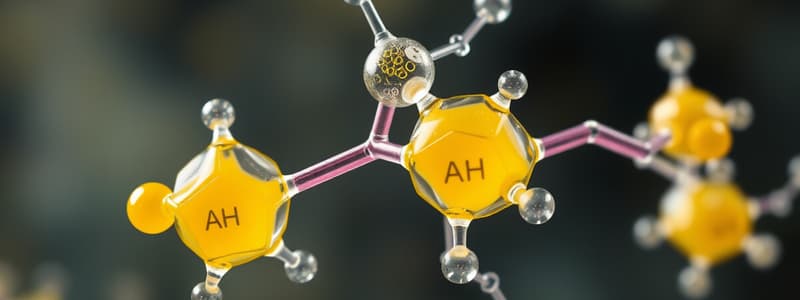Podcast
Questions and Answers
What enzymatic reaction occurs to convert citrate into isocitrate?
What enzymatic reaction occurs to convert citrate into isocitrate?
- Isomerization via cis-aconitate (correct)
- Hydration
- Oxidation
- Decarboxylation
What is produced during the oxidative decarboxylation steps of the TCA cycle?
What is produced during the oxidative decarboxylation steps of the TCA cycle?
- ATP
- FADH2 (correct)
- GTP
- CO2 (correct)
Which enzyme catalyzes the conversion of malate to oxaloacetate?
Which enzyme catalyzes the conversion of malate to oxaloacetate?
- Succin dehydrogenase
- Citrate synthase
- Aconitase
- Malate dehydrogenase (correct)
What type of group acts as a coenzyme for aconitase during the isomerization process?
What type of group acts as a coenzyme for aconitase during the isomerization process?
Which product is generated by substrate-level phosphorylation in the TCA cycle?
Which product is generated by substrate-level phosphorylation in the TCA cycle?
What is the consequence of fluoroacetate poisoning on the TCA cycle?
What is the consequence of fluoroacetate poisoning on the TCA cycle?
What is a characteristic feature of the TCA cycle in relation to metabolism?
What is a characteristic feature of the TCA cycle in relation to metabolism?
Which of the following substrates enters the TCA cycle after being converted to Acetyl-CoA?
Which of the following substrates enters the TCA cycle after being converted to Acetyl-CoA?
What is the primary function of Coenzyme A in cellular metabolism?
What is the primary function of Coenzyme A in cellular metabolism?
Which statement about coenzymes is true?
Which statement about coenzymes is true?
Which of the following is not a prosthetic group in the Pyruvate Dehydrogenase Complex?
Which of the following is not a prosthetic group in the Pyruvate Dehydrogenase Complex?
What is the main consequence of thiamine deficiency in relation to pyruvate metabolism?
What is the main consequence of thiamine deficiency in relation to pyruvate metabolism?
What does the oxidative decarboxylation of pyruvate primarily produce?
What does the oxidative decarboxylation of pyruvate primarily produce?
How many turns of the TCA cycle occur per glucose molecule?
How many turns of the TCA cycle occur per glucose molecule?
What is a characteristic feature of the Pyruvate Dehydrogenase Complex?
What is a characteristic feature of the Pyruvate Dehydrogenase Complex?
Which vitamin is NOT correctly associated with its function in metabolism?
Which vitamin is NOT correctly associated with its function in metabolism?
Study Notes
Coenzyme A and Coenzymes
- Coenzyme A (CoA) is essential for accepting and transporting acetyl groups.
- Coenzymes are transient molecules, participating in enzyme functions without being permanently part of the enzyme’s structure.
Conversion of Pyruvate to Acetyl-CoA
- Pyruvate conversion is catalyzed by the Pyruvate Dehydrogenase Complex (PDC).
- PDC requires five coenzymes for its function, including three prosthetic groups: Thiamine pyrophosphate (TPP), lipoyllysine, and FAD, all covalently bound.
- NAD+ and CoA-SH function as co-substrates during this process.
Pyruvate Dehydrogenase Complex (PDC)
- PDC can reach sizes up to 10 MDa and is found in the mitochondrial matrix of eukaryotic cells.
- It consists of three functional proteins and coordinates three sequential enzymatic reactions:
- Enzyme 1: Converts pyruvate to a hydroxyethyl intermediate, followed by oxidation.
- Enzyme 2: Forms acetyl-CoA.
- Enzyme 3: Reduces FAD and oxidizes lipoyllysine, converting FADH2 to reduce NAD.
Advantages of Substrate Channelling in PDC
- Substrate channelling maintains high local concentrations of substrates and prevents intermediates from diffusing away.
- This mechanism enhances the efficiency of acetyl group use.
B Vitamins and Their Role
- TPP is a derivative of Vitamin B1, while NAD+ corresponds to Vitamin B3 (niacin).
- Coenzyme A contains pantothenic acid (Vitamin B5).
- Riboflavin (B2) plays a role in the electron transport chain, and biotin (B7) is important for gluconeogenesis.
- Thiamine deficiencies can disrupt normal pyruvate oxidation, particularly affecting brain function, leading to conditions like Beri-beri.
The TCA Cycle
- Also known as the Tricarboxylic acid cycle, Krebs cycle, or citric acid cycle, it metabolizes acetyl-CoA.
- The cycle produces byproducts including 2 CO2, 3 NADH, 1 FADH2, and 1 GTP, with each glucose molecule leading to two cycles.
TCA Cycle Steps
- Steps involve citrate formation, isomerization, oxidative decarboxylation yielding NADH, substrate-level phosphorylation for GTP, and further oxidations to regenerate NADH.
- Aconitase catalyzes the isomerization of citrate to isocitrate using an iron-sulfur coenzyme.
Key Points in TCA Cycle
- α-Ketoglutarate Dehydrogenase has similar characteristics to PDC, employing identical coenzymes and mechanisms.
- TCA intermediates serve as critical biosynthetic precursors, integrating various metabolic pathways.
Malate Shuttle
- NADH generated in glycolysis cannot directly enter mitochondria; instead, it relies on the malate-aspartate shuttle.
- Cytoplasmic malate dehydrogenase converts oxaloacetate to malate, which then enters mitochondria for regeneration of NADH.
Case Study: Fluoroacetate (1080)
- Used to control feral dingo populations; poisoning leads to symptoms like excessive howling, seizures, and eventual death.
- Fluoroacetate disrupts the TCA cycle by binding aconitase, resulting in elevated citrate levels causing hypocalcemia and decreased ATP production.
Summary
- Cellular respiration consists of three stages, with the TCA cycle being the second stage.
- Acetyl-CoA enters the TCA cycle with the net reaction producing reduced cofactors and CO2.
- There are two oxidative decarboxylation steps within the cycle, crucial for cellular metabolism.
Studying That Suits You
Use AI to generate personalized quizzes and flashcards to suit your learning preferences.
Description
Explore the crucial role of Coenzyme A in acetyl group transport and the function of the Pyruvate Dehydrogenase Complex in converting pyruvate to acetyl-CoA. This quiz covers the essential coenzymes and enzymatic reactions involved in this metabolic pathway. Test your understanding of these fundamental biochemistry concepts!




